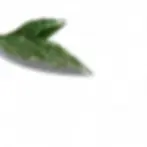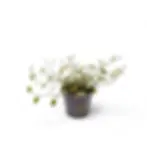Philodendron melanochrysum – Luxurious Velvet Climber for Statement Indoor Greenery
Philodendron melanochrysum is one of the most dramatic velvet-leaf aroids you can grow indoors. Its elongated, heart-shaped leaves unfurl in bronze or copper before darkening into deep green with golden shimmer. Native to Colombia and Ecuador’s cloud forests, this rare climbing plant turns any vertical space into a botanical showpiece.
● What Makes Philodendron melanochrysum Special?
- Velvet-textured foliage with deep green tones and subtle gold sparkle in the right light
- Massive mature leaves – over 100 cm when properly supported and well-lit
- Fast vertical growth with thick stems and prominent aerial roots
- Rare in cultivation – a must-have for serious Philodendron collectors
● Natural Habitat and Growth Traits
- Origin: Tropical montane forests of Colombia and Ecuador
- Elevation: Occurs naturally between 500 and 1500 m
- Growth form: Evergreen, hemiepiphytic climber
- Toxicity: Toxic to pets and people if ingested – due to calcium oxalates
● How to Care for Philodendron melanochrysum Indoors
Lighting and Water
- Light: Bright, indirect light is essential. Avoid harsh direct sun but don’t go too dim.
- Watering: Water when the top 3 – 5 cm of substrate dries. Keep moist but never soggy.
Humidity and Temperature
- Humidity: 70%+ recommended – use a humidifier or group with other plants
- Temperature: 18 – 26 °C is ideal. Protect from cold air or rapid temperature changes.
Soil and Feeding
- Substrate: Use a chunky aroid mix with orchid bark, perlite, and coconut coir
- Feeding: Fertilize monthly with a balanced liquid plant food
Repotting and Support
- Repotting: Every 1 – 2 years or when rootbound. Always use a pot with drainage holes.
- Support: A moss pole or coir totem helps it grow taller and produce mature leaves
● Propagation and Growing Options
- Cuttings: Propagate via stem cuttings with one or more nodes
- Rooting: Place cuttings in water, sphagnum moss, or semi-hydroponics (LECA)
- Semi-hydro: Adapts well to LECA or Pon after root adjustment
- Pruning: Trim damaged or leggy growth to shape and encourage density
● Troubleshooting Philodendron melanochrysum
- Yellow leaves: Most often caused by overwatering or poor drainage
- Brown leaf edges: Typically due to dry air or uneven watering
- Small leaf size: Lack of support or too little light – give it both to scale up
- Pests: Prone to spider mites, thrips, and mealybugs – treat early with insecticidal soap or neem
- Root rot: Avoid by using airy substrate and allowing the top layer to dry between waterings
● Expert Tips for Lush Growth
- Place near a bright window, but always protect from direct midday sun
- Use a humidifier to stabilize air moisture above 70%
- Clean velvet leaves gently using leaf-cleaning gloves to avoid damage
- Rotate monthly for balanced growth and even leaf development
● Botanical Name and Etymology
Philodendron comes from the Greek "philo" (love) and "dendron" (tree), a nod to its climbing habit. The species name melanochrysum combines “melano” (black) and “chrysum” (gold), referencing the dark leaves with golden shimmer. Described by Jean Jules Linden and Édouard André in 1873 in Illustration Horticole.
● FAQs – Philodendron melanochrysum
- Can it grow in low light? It will survive, but growth slows and leaves stay smaller
- How to get larger leaves? Bright indirect light, high humidity, and vertical support
- Is it pet-safe? No – like most aroids, it's toxic if chewed or swallowed
- Can I grow it in LECA? Yes, with gradual root acclimation and stable humidity
● Order Philodendron melanochrysum Online
Add this velvet-leaf climbing legend to your indoor jungle
Philodendron melanochrysum
Philodendron melanochrysum comes in following sizes:
Plug (Starter Plant) – ⌀ 2 cm, is approximately 10 cm tall
Baby Plant – is approximately 10 cm tall and comes in a ⌀ 6 cm pot
S – is approximately 20 cm tall and comes in a ⌀ 9 cm pot
M – is approximately 40 cm tall and comes in a ⌀ 12 cm pot
L – is approximately 50 cm tall and comes in a ⌀ 17 cm pot
XL – is approximately 75 cm tall and comes in a ⌀ 21 cm pot






























